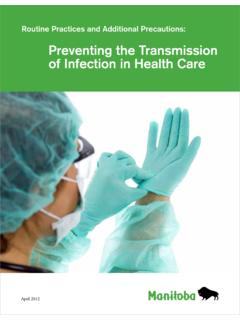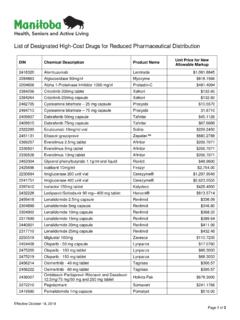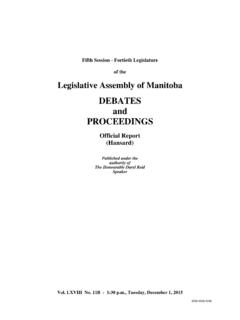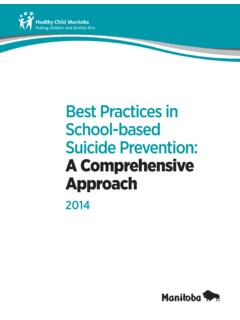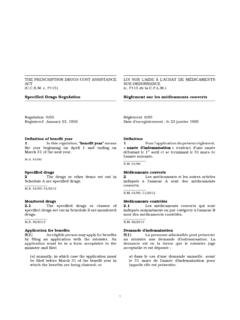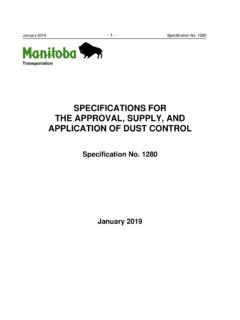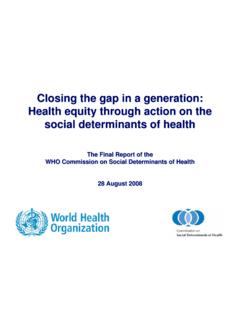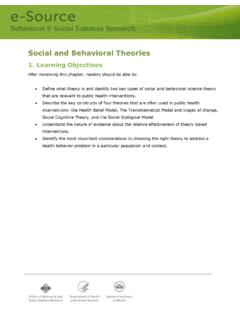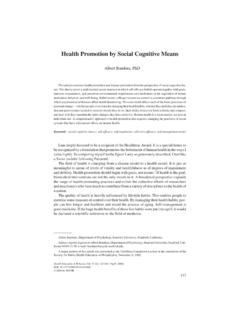Transcription of The Role of the Public Health Nurse - Manitoba
1 ManitobaHealthThe Role of the Public Health Nurse within the Regional Health AuthorityAcknowledgmentsThe Public Health nurses of Manitoba Health collaborated with City of Winnipegpublic Health nurses in preparing The Role of the Public Health Nurse within theRegional Health would like to thank everyone who participated in thepreparation of this 1998 Additional copies are available from: Manitoba HealthCommunity Health Assessment UnitFax: (204) 772-2943 Internet: Shift From Illness to Health4 Public Health Nursing is Integral to Regional Health Services5 Public Health Nursing An Overview7 Public Health Nursing Exemplifies The ProvincialParadigm Shift8 Health Promotion, Illness Prevention and HealthProtection9 Role of the Public Health Nurse in the Delivery of Core Services11 Health Promotion12 Prevention13 Health Protection14 Outcomes of PHN Services15 Conclusion15 References16 Appendix A17 Contents23 This document describes the role of Public Health nursing within Manitoba sRegional Health Authorities.
2 Health promotion, illness prevention and healthprotection are core services of the Regional Health Authorities and core functionsof the Public Health Nurse . This paper illustrates how Public Health nursing practiceexemplifies the provincial paradigm shift which focuses on: nthe broad determinants of Health , nequity of Health , nintersectoral approaches, nhealth rather than an illness system, npartnerships with the community, ninvestments in Health promotion and disease prevention, andnevidence-based Health addition to discussing the paradigm shift from illness to Health , this paper willalso address the following areas:nPublic Health Nursing is Integral to Regional Health Services nPublic Health Nursing - An Overview n Public Health Nursing Exemplifies the Provincial Paradigm Shift nHealth Promotion, Illness Prevention and Health Protection nRole of Public Health Nursing in the Delivery of Core Servicesn Outcomes of Public Health Nursing ServicesIntroduction4 Health is a resource for life, not the object of living; it is a positive conceptemphasizing social and personal resources, as well as physical capacities (WorldHealth Organization, 1986).
3 The new view of Health demands a funding andresource revolution from an illness focus to a balanced resource allocation forwellness. This resource shift is not likely to occur without controversy and confusionbecause of the persistent belief that Health is the absence of disease or illness. Thereis growing awareness of the many determinants of Health , most of which are entirelyoutside of the current Health communities have highly variable and unique strengths and Health needs. TheRegional Health Authorities (RHAs) will provide solid foundations for service andstaffing decisions to support the move to Health oriented care based on ongoingcommunity Health assessments and the core services as defined by Manitoba following chart is a graphic representation of where Public Health nursingservices predominate within the continuum of regional Health services.
4 (Adapted from Quality Health for Manitobans: The Action Plan,1992)Paradigm Shift From Illness to HealthHealth ContinuumRestructuring the system towards a more appropriately balanced continuum of servicesHealthy PublicPolicyPreventionPromotionProtectio nSupportServicestoSeniorsCommunityHealth CentresOutpatientAmbulatoryCareRural CommunityUrbanCommunityTertiaryPalliatio nRehabilitationHospitalsExtendedTreatmen t &Long-Term CareCommunityOrientedServicesHome CarePublic HealthNursing5 Key elements of the role and function of the Public Health Nurse (PHN) within theregional Health structure:nCore PHN services are delivered within a community-based framework. Community-based services are driven by the needs and resources of thecommunity and its neighbourhoods. PHNs assess communities on a daily basiswhile working with individuals, families and groups in the neighbourhood,schools, workplaces and are community leaders.
5 PHNs work with community groups, negotiate partnerships and buildcollaborative initiatives. They are well positioned to manage the delivery of awide variety of services within a restructured are effective members and often leaders of interdisciplinary andintersectoral teams. Through recognition of the importance of the determinants of Health , PHNsdevelop integrated approaches to address Health issues. It is throughinterdisciplinary and intersectoral linkages within communities that PHNsaffect the determinants of Health . PHNs are community and Public Health experts. PHNs can readily provideleadership to a team of community practitioners ( , audiologists, healtheducators, physicians, Health inspectors, peer outreach workers).nPHNs can be integral members of neighbourhood resource networks andcommunity Nurse resource centres.
6 Community Nurse resource centres (CNRCs) and PHN services arecomplementary. PHN services share four central components of CNRCs :primary Health care, community development, education and outreach, andresearch. Both PHN and CNRC services are based on community assessment ofneeds and assets, and include evaluation components. PHN services differ in that they include those services mandated under thePublic Health Act ( , communicable disease prevention and control). Public Health Nursing is Integralto Regional Health Services6nPHNs must continue to have provincial, national and international linkages. These linkages allow PHNs across the country to learn from, and providedirection regarding the broader implications of policy and to develop commonstrategies. These linkages reduce duplication in effort, human and fiscalresources ( , trends in emerging communicable diseases, otherepidemiological issues, community development, school Health and healthychild development).
7 NPublic Health nursing services are directed to the general population withpriority given to high-risk populations. For maximum effectiveness, illness preventionefforts are targeted to identifyand intervene with those who are at high-risk of injury or illness. While Health promotionis relevant to everyone and to all communitiesregardless of risk status, it may be most effective to target Health promotionresources to those populations which have the poorest Health status. Some Health protectionservices apply to high-risk groups while others apply tothe general population. nPublic Health nursing services should be provided by designated PHN positionsseparate from other nurses based in the community. A Health promotion and illness prevention focus is very different from anillness treatment and care model such as home care and palliative care.
8 Somepersons currently classified as Public Health nurses in collective agreementsmay have functions different or in addition to those identified in thisdocument ( , long-term care, home care). An illness prevention, Health protection and Health promotion focus needs tobe kept as a priority for all communities. As we shift into an integrated healthcare model we need to ensure that illness care and treatment demands do notrob the community of its ability to address long-term investments in Health . Research demonstrates that long-term investments in Health provide financialsavings and personal and community Health Health nursing focuses on the Health of entire populations or services are provided to individuals and families within the context of thehealth of the larger community. PHN expertise is in the promotion and protection ofhealth and the prevention of understand that the Health of individualsand communities directly relates to the determinants of Health such as housing,income, employment, education, sanitation and safety.
9 PHN practice aims to improve the Health of all people and minimizes healthdifferences among populations by addressing determinants of Health . PHNsunderstand that equity is a key aspect of the determinants of is an organized system of practice which:nsynthesizes knowledge from Public Health sciences and professionalnursing theory;nis comprehensive and holistic in its approach;nworks with community members, other Health care professionals,disciplines and sectors;npromotes linkages between individuals, communities, the broader healthsystem and other Health determining sectors; andnworks with communities to develop specific services, programs andstrategies (Adapted from Community Health - Public Health Nursing,Canadian Public Health Association, 1990).PHNs are generalist practitioners with expertise in areas such as communicablediseases, maternal-child and school Health .
10 PHNs deliver services within acommunity-based model. Services are driven by the needs and resources of adefined community. PHNs work with and not on communities. PHNs have skills and experience in assessing community assets and needs, inplanning and implementing community development strategies combined with abroad base of knowledge related to Health and Health have a major responsibility for implementing legislated services to control healthhazards and communicable diseases as found in The Public Health Act, the Food andFood Establishment Regulation and the Diseases and Dead Body Regulation. PHN practice is client-centred and incorporates the strategies of empowering,enabling, advocating, co-operating and collaborating when working withindividuals, communities and colleagues both with the Health system and with other sectors (Focus on Health ,Canadian Public Health Association, 1996).
